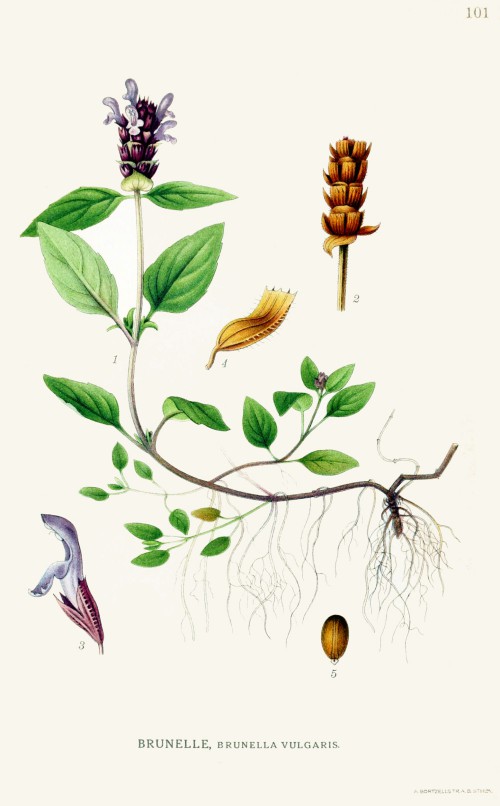Prunella vulgaris L. - Lamiaceae - 夏枯草 xia ku cao (chin.), (common) selfheal, heal-all, Gemeine Braunelle, Kleine Braunelle
Perennial herb, up to 30cm high, exact native range unknown, found in Europe, North Africa, Asia and North America; base much branched, purple-red; leaves lanceolate to oblong-lanceolate, up to 4cm long (var.lanceolata) or ovate-oblong to ovate, up to 6cm long (var.vulgaris); bracts purplish, broadly cordate; calyx campanulate, ca. 1cm; upper lip suboblate, subtruncate; lower lip narrower, teeth acuminate; corolla purplish or white, ca. 1.3cm. http://www.efloras.org/florataxon.aspx?flora_id=2&taxon_id=200020053
Prunella vulgaris L. subsp. asiatica (Nakai) H. Hara = Prunella asiatica Nakai
https://npgsweb.ars-grin.gov/gringlobal/taxonomydetail.aspx?id=459327
The spikes, Chinese drug name PhPRC 2010: Prunellae spica, Xiakucao, 夏枯草, are used to treat red or
painful, swollen eyes, photophobia, visual disturbances and loss, head ache, sore and swollen throat, painful lumps, knots nodes at the neck and throat. PhEur 7.6 demands min. 0.12% ursolic acid and oleanic acid
(not less than 75% ursolic acid), PhPRC 2010 demands min. 0.20% rosmarinic acid.
http://www.lfl.bayern.de/mam/cms07/publikationen/daten/merkblaetter/chinese_medicinal_plants__cultivated_bavaria_lfl-merkblatt.pdf
Indications for P.vulgaris are dizziness due to hypertension, headache, tinnitus, and conjunctivitis.
[Medicinal plants in China: a selection of 150 commonly used species., World Health Organization., 1989, 230-231]
P. vulgaris extract and rosmarinic acid, used in skin care cosmetics, demonstrated a concentration-dependent photoprotection (maximum at 25-50 mg/l and 9 mg/l, respectively) and thus may may be beneficial as a supplement in photoprotective dermatological preparations.
[Photoprotective properties of Prunella vulgaris and rosmarinic acid on human keratinocytes., Psotova, J., Svobodova, A., Kolarova, H., Walterova, D., Journal of Photochemistry and Photobiology B: Biology, 84(3), 2006, 167-174]
Ethanol extracts of P. vulgaris showed anti-inflammatory activity by significantly inhibiting lipopolysaccharide (LPS)-stimulated prostaglandin E2 (PGE2) and nitric oxide (NO) production at 30 μg/mL without affecting cell viability. „Rosmarinic acid (RA) content in P. vulgaris was found to independently inhibit inflammatory response, but it only partially explained the extracts’ activity. LPS-induced cyclooxygenase-2 (COX-2) and nitric oxide synthase (iNOS) protein expression were both attenuated by P. vulgaris ethanol extracts, whereas RA inhibited only COX-2 expression.“
[Rosmarinic acid in Prunella vulgaris ethanol extract inhibits lipopolysaccharide-induced prostaglandin E2 and nitric oxide in RAW 264.7 mouse macrophages., Huang, N., Hauck, C., Yum, M.Y., Rizshsky, L., Widrlechner, M.P., McCoy, J.A., Birt, D.F., Journal of agricultural and food chemistry, 57(22), 2009, 10579-10589] http://www.ncbi.nlm.nih.gov/pmc/articles/PMC2795400/

P.vulgaris as Brunella vulgaris; Lindman, C.A.M., Bilder ur Nordens Flora, vol.1 t.101 (1922-1926)
http://plantgenera.org/species.php?id_species=841357
